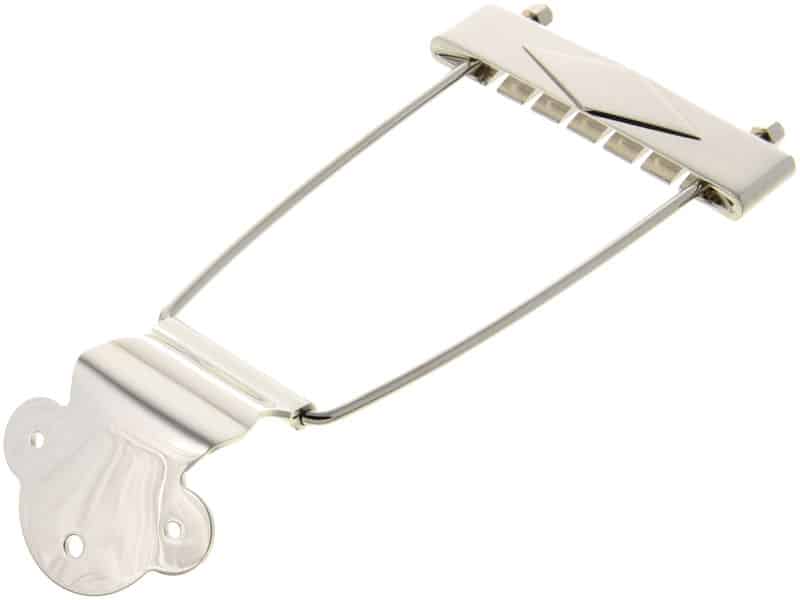Most archtop guitars have tailpieces, and this might be a confusing topic for many players. Especially for those of us who started playing with more modern models.
Some may love them, many will think that they belong in a museum, but all guitar nerds will want to know if these string-stopping contraptions have something to add or subtract to an instrument’s tone.
Getting to the main topic of this article then: Do guitar tailpieces affect tone?
Guitar tailpieces do affect tone, slightly. The added or subtracted mass to the body of the instrument will have an implication in resonance. However, many players claim that the tonal effects come from changes in string height they make possible. Higher strings sound darker, while lower ones, brighter.
For those who want to dive deeper into this topic, in this article I will start by talking about their effect on tone more in detail.
After that, I will list and describe the most common models of this guitar part you most probably will find out there.
Finally, I will give you my conclusions and recommendations about what I think should be your approach when picking a new guitar with a tailpiece.
Are you ready to get started?
Let’s go!
What does a tailpiece do on a guitar?
The tailpiece is where the strings start their journey to the tuners. Its main function is to hold them in place while taking the strength of the tension generated by tuning them up. It’s important to not confuse the tailpiece with the bridge, although there are bridges that also act as a tailpiece.
An example of this last kind is the wraparound bridges commonly used on Gibson-style guitars.
Tailpiece vs bridge, main differences
The main difference between a tailpiece and a bridge is their function. Although there are bridges that also work as tailpieces, their job is to be one of the 2 points of contact of the vibrating part of the string and help define string spacing, action, and intonation. Tailpieces just hold strings in place.
Do tailpieces affect a guitar’s tone?
Tailpieces have an impact on tone. Adding or subtracting mass from the body of a guitar will have an impact on how it resonates. Also, with some tailpieces, it is possible to control the height and break angle of the strings. A higher tailpiece makes the tone darker, and a lower one makes it brighter.
How much do tailpieces affect a guitar’s tone?
Quantifying how much a certain aspect of a guitar influences its tone is no easy task. It would require extensive scientific research to arrive at conclusive results.
What I can offer you is empirical evidence, based on the opinion of many players.
The tailpiece will probably not have a significant influence on the tone of the instrument. Some people argue they notice changes when tuning its height, while others claim they hear nothing different.
It’s likely that the bridge has more effect on how a guitar sounds, however, there are way more impactful features of a guitar, in terms of tone, such as tonewoods, pickups, and construction type.
Most common tailpieces and their main characteristics
Tailpieces come in various designs and shapes. Here are the 4 most common ones with a brief description of their quirks and features.
Stop tailpiece

Stop tailpieces are some of the most simple and popular ones.
They are simply a metal bar, with slots for the strings to pass through, attached to the body of the guitar with 2 big screws.
Gibson usually pairs them with tune-o-matic bridges that allow for more granular control over intonation and action.
This kind of tailpiece has no fundamental drawbacks and is very easy to work with, being a great alternative for new players.
Trapeze

Trapeze tailpieces are mostly common on archtop, hollow and semi-hollow guitars. They are preferred by many jazz players.
In terms of functionality, this kind of tailpiece attaches to the guitar’s heel and has slots through where the strings feed. When strings are later tensioned they suspend until they reach the bridge.
Many players argue that this suspended design leads to a more vibrant and resonant experience, and this is always good.
Also, the tension of the strings, with this design is applied to the edge of the guitar body, instead of the middle.
This form of tailpiece is, however, rather hard to work with, and will take some time to get used to.
Vibrato

Vibrato tailpieces come in very different forms and flavors. Some people might argue that even Fender synchronized bridges can be considered into this category.
For the sake of simplicity, I will exclude what’s known as tremolo systems such as Floyd Rose bridges and focus mainly on units that don’t incorporate a bridge in their design.
Yes, I’m talking about Bigsbys here.
Vibrato tailpieces such as the ones offered under the Bigsby brand have an extra function: They change the tension of the strings on demand.
Usually, this is done by working their whammy bar which rotates the whole mechanism, moving the breakpoint of the strings slightly closer to the direction they are pulling. This decreases their tension.
These kinds of tailpieces have a bad rep for compromising the tunning stability of the instrument and being a pain to work with.
However, they will help you achieve amazing sounds.
Wrap-around

Wrap-around tailpieces are other of the most common and practical designs for this part of the guitar.
They hold strings in position and, as the name implies, then wrap them around a metal bar.
In some cases, some manufacturers choose to use these as a standalone solution, with no need for a bridge.
In other, probably more premium situations, they are commonly coupled with bridges like the ubiquitous tune-o-matic to allow for better control of intonation and string action.
This design is simple and just works, and perhaps that’s why many players love it.
Some people even go as far as to claim it adds some resonance and sustain to the instrument.
Conclusions and recommendations
Whether you are looking for a new guitar or planning on building or having one built, getting to know, at least at a high level how tailpieces work is, in my opinion, something that will help you make a better informed final decision.
However, here in GearAficionado, I always say that you should try out every instrument before buying it if you have the chance.
I don’t think anyone can really understand the sound of all these different tailpieces without getting to hear them live. At least the ones that you think might work out better for you.
Also, it’s very likely that there would be more variance in tone within 2 different guitars of the same model than in the resulting tones of the same guitar when tested with 2 different tailpieces.
If it’s within your reach, try to get to play completely different guitars to clearly understand where the variation lies, and then start checking out ones closer to the one you preferred the most.
Finally, don’t forget to have fun. Technicalities for some people get the joy out of getting a new piece of gear. You don’t have to know it all about something that makes you smile. Just go and play the instrument that feels best to you.

Hello there, my name is Ramiro and I’ve been playing guitar for almost 20 years. I’m obsessed with everything gear-related and I thought it might be worth sharing it. From guitars, pedals, amps, and synths to studio gear and production tips, I hope you find what I post here useful, and I’ll try my best to keep it entertaining also.





